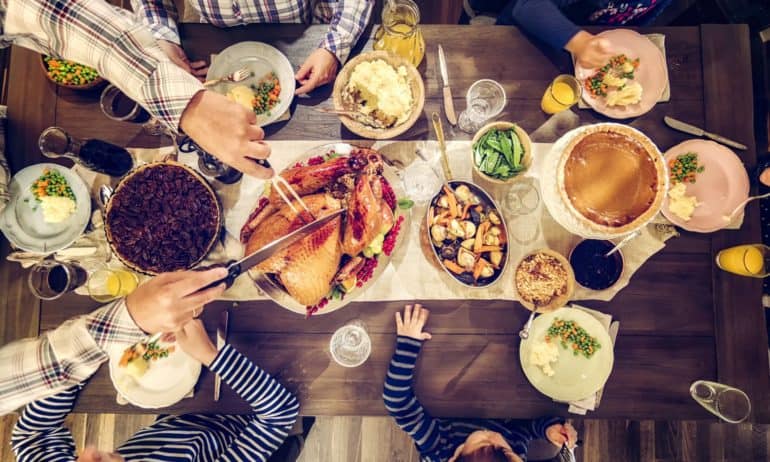Thanksgiving is the holiday that reminds all of as eaters to be grateful, especially for the season’s bounty provided by farmers, farm laborers, chefs, and food service workers. But, unfortunately, we also waste an astonishing amount of food.
Each year, consumers purchase over 700 million pounds of turkey, according to the National Turkey Federation. The U.S. Department of Agriculture (USDA) projects that 35 percent of the meat purchased does not get eaten–ending up in landfills, along with sweet potatoes, green beans, pumpkin pie, and other holiday fare.
Around the globe, roughly one-third of the food produced for human consumption gets lost or wasted. This amounts to about 1.3 billion tons per year–which is enough to feed the nearly 1 billion people who are hungry today. A report by the Barilla Center for Food & Nutrition found that 110 kg of edible food is wasted in households in the United States, 108 kg in Italy, 99 kg in France, 82 kg in Germany, and 72 kg in Sweden.
While food waste presents some serious moral challenges, it’s also an environmental issue. The U.N. Environment Programme reports that the food wasted annually is responsible for adding 3.3 billion tons of greenhouse gasses to the planet’s atmosphere.
Thankfully, organizations like the World Resources Institute (WRI), the Natural Resources Defense Council (NRDC), Feedback, and the coalition of funders and organizations called ReFED are fighting to put an end to food waste by measuring food loss and setting goals to prevent it. WRI, for example, launched the first-ever Accounting and Reporting Standard for food loss and waste this year, and they are champions of the Sustainable Development Goal that aims to cut per capita global food waste in half. And ReFED produced this video highlighting food waste in the U.S.
This Thanksgiving, one of the best ways to be grateful for what you have is to avoid wasting it. Here are tips for a waste-free holiday.
PLAN AHEAD.
It’s easy to avoid buying and preparing too much food if you make a plan for your feast. Get an exact headcount of how many guests you will have and then coordinate what dishes will be served. According to the NRDC, you should consider the fact that there will be plenty of dishes available to eat, so each person may not need a full portion size of every dish. Use a portion calculator, and then “try knocking the number to ¾ of the actual number of people you expect. If it’s a recipe you use often, take notes after the party to remind yourself how appropriate your multiplication was,” says Dana Gunders, senior scientist at the NRDC.
USE WHAT YOU HAVE.
Once you know your numbers and your dishes, take a look in your refrigerator or pantry to see what ingredients you already have before heading to the store. Sometimes, cans or jars hide in the very back of your storage area, where you forget about them. If this happens to you often, consider using Fridgely, an app that lets you record and track what’s in your fridge.
When you find a long lost food item, use your judgment regarding “sell by” or “best by” dates, as they are just guidelines. Products may still be good long after their expiration date. Author and food waste expert Jonathan Bloom suggests, “look, smell, and if it comes to it, taste it before you throw it away.”
After taking stock of your ingredients, make a shopping list using the proportions you’ve calculated and only buy what you need. The U.S. Environmental Protection Agency (EPA) recommends marking quantities on your list, so you remember exactly how much to buy.
RESCUE DISCARDED “WASTE.”
We throw away many food items that are perfectly good just because they are traditionally considered to be garbage. Turkey giblets, bones, stale bread, and vegetable scraps all have value beyond the compost pile. The EPA suggests repurposing these items to prevent waste and save money. Stale bread makes great croutons or stuffing, vegetable tops and bones can be turned into highly nutritious, flavorful soup stock, and turkey giblets add flavor to gravy.
ALLOW GUESTS TO SERVE THEMSELVES.
Instead of scooping out huge portions of dishes, let guests gauge their hunger levels and serve themselves the amount they want to eat. A buffet or family-style meal will help minimize plate waste. Guests should be mindful of taking just what they want, because it’s always better to come back for seconds than to leave uneaten food on a plate. Using smaller plates for the meal can help control portion sizes.
STORE FOOD PROPERLY AFTER THE MEAL.
It’s tempting to sit and relax for hours after eating, but leaving food out can lead to bacterial contamination. The USDA’s Food Safety and Inspection Service (FSIS) warns that the “danger zone” for food is from 40°F to 140°F. Bacteria like Salmonella and E. coli grow most rapidly in this temperature range, so you should never leave food at room temperature for more than two hours. After everyone finishes eating, clean up your feast quickly and then enjoy the rest of your evening.
LOVE YOUR LEFTOVERS.
As you’re packing up the meal, figure out the best way to deal with the leftovers. Store some of the food in your own fridge to repurpose in interesting new recipes. Cooking with leftovers makes dinner a simple and quick affair. Plus, provide plenty of reusable containers for guests to take some of the feast home with them. Gunders suggests using old yogurt containers to send with guests, or ask each person to bring a container for themselves.
DONATE TO FEED THE HUNGRY.
If you still end up with too much food, you can locate a local food bank and donate your excess food to those in need. Also check out organizations such as D.C. Central Kitchen and City Harvest, which use donated food to cook meals for those in need.






